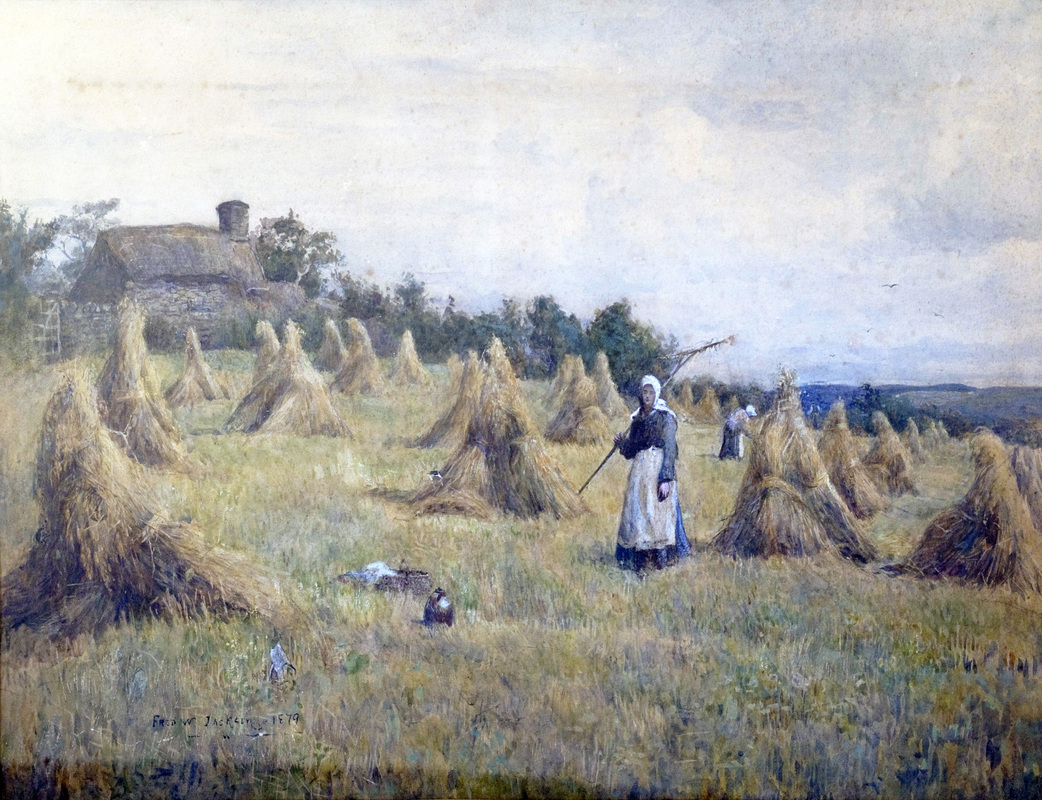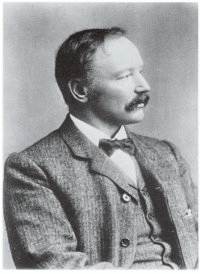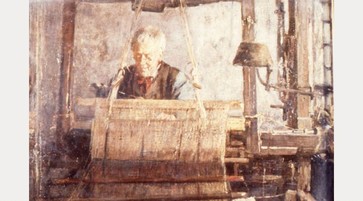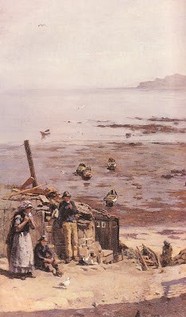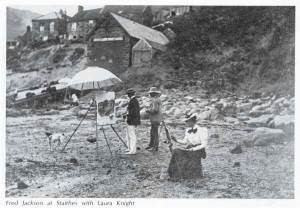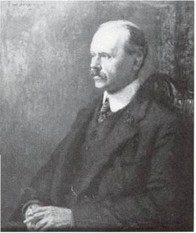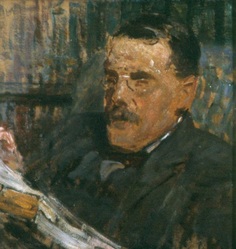Harvest Time
|
Research by Jacqueline Arundel
|
|
PAINTING
Harvest Time is a watercolour painted by Fredrick William Jackson RBA in 1879. Watercolour sketches were an important part of Jackson’s production. This gentle and sentimental painting was probably painted ‘en plein-air’ (outside), as it feels atmospheric with a great sense of breadth and light. Jackson loved to paint outside in nature, often to the detriment of his health. Using a spontaneous, loosely handled technique, with fine tonal gradations, a painterly effect has been created. The subject matter depicts the world of peasants and rural labour. Here, we see a traditional scene of two women raking the corn after it has been reaped (cut). Swathes of cut grain stalks are gathered into bunches, sheaves (singular sheaf), and tied with string or a twist of straw. Several sheaves are then leant against each other with the ears off the ground to ripen and dry out, forming a stook. This hard physical labour could take several days for each field of corn. The central figure stands looking at the artist with her wooden rake in hand, her basket with bread for food and a stoneware jug of water are set amongst the corn. ARTIST
Fred Jackson was liked and respected in his day, praised as an artist and renowned for his landscape and marine paintings. It was generally felt that he could have achieved the distinction of RA had it not been for his reticence and modesty. (Jacobs, 1980) He was born in 1859 at Middleton Junction, Oldham, one of three children, whose father was a photographer. His two brothers were Vincent Jackson, a musician trained at Leipzig Conservatoire, and Charles Arthur Jackson, an art dealer and Manchester gallery owner. Charles supported his brother during his career, helping with both money and materials. Many of Jackson's pictures bear labels inscribed with the address of his brother's gallery, 7 Police Street, Manchester. (Jackson, 2014) Jackson died in 1918, aged 59, and was buried in his native Middleton. (Jacobs, 1980) Manchester School - Jackson had relatively little formal training, however, his interest in painting was evident from an early age. As a boy he went on sketching tours with his friend, the future architect, Edgar Wood. After leaving school he attended evening classes at Oldham School of Art, where he studied painting under John Houghton Hague (1842-1934). Hague's brother, Joshua Anderson Hague (1850-1916), was the leader of a group of young artists known as the 'Manchester School'. This group was making a considerable impact in the mid-1870s and Jackson was drawn towards them. Nearly all these artists had been trained at Manchester Academy of Fine Art and they met together in Wales in the early 1870s at the studio of the self- taught Joseph Knight (1837-1909). They were influenced by the Barbizon School of painters, mid-19th century painters who worked in and around the village of Barbizon on the outskirts of the forest of Fontainebleau, southeast of Paris, and also by Dutch painters, Anthonij (Anton) Rudolf Mauve (1838-1888) and Jozef Israëls (1824-1911), at a time when, in Britain, Dutch paintings were in demand. Samuel Barlow (1825-1892), a rich dye works man and an important influence on the cultural world of Manchester, was an early patron of Jackson. He paid him £200 a year for five years between 1879 and 1884 and in return Jackson gave him all the works he produced. Like Jackson, he lived for some years in Middleton, near Manchester. Ironically, Barlow made his money from his bleaching business, which had a devastating effect on the local countryside, but in his home he surrounded himself with beautiful objects. Following Barlow's death in 1892, local art dealers, Capes, Dunn and Pilcher, auctioned a part of his art collection in Manchester. The sales catalogue showed the large number of Jackson's paintings that Barlow owned. Most of these were produced in the early part of his career. (Slater, 2010) Lytham St Annes Art Collection’s Harvest Time (1879) was probably bought at this auction. Following Jackson’s Manchester Academy exhibitions of 1880 and 1881 he was elected a member of the Manchester Academy of Fine Art. (Jackson, 2014) Arts Club - In 1879 Jackson was made a member of the Arts Club (1863-1896), founded and based in Dover Street, Mayfair, London by, amongst others, English writer and social critic, Charles Dickens (1812-1870), English novelist, Anthony Trollope (1815-1882) and English painter and sculptor, Lord Fredrick Leighton PRA (1830-1896). Although a social venue it was known to be a place where influence could be exerted and careers developed. It was seen as the powerhouse behind the dealings of the Royal Academy. North Wales - During 1880-81 Jackson was made a member of the Limners Club. That same year he went to live in Plas Mawr, Conway, North Wales, where a considerable number of Manchester artists were already living. These included artists, Henry Clarence Whaite, known as Clarence Whaite (1828–1912), Joshua Anderson Hague and Edward Norbury, who were planning to found the Royal Cambrian Academy (founded 1881). France - Despite a strong native tradition of landscape painting in Britain, 19th century French landscape painters attracted the young artists of Jackson's day. So it was inevitable that Jackson, as a young artist, should be drawn to France, which had superseded Italy as Europe's artistic centre. (Cross, 1978) In 1885 Jackson went to Paris and enrolled as a student at the Académie Julian where, although their students took exams at the École des Beaux-Arts, they also offered independent teaching. (Hoyle, 2014) Jackson studied under Jules Joseph Lefebvre (1836-1911), a French figure painter, educator and theorist, many of whose paintings are single figures of beautiful women, and Gustave Boulanger (1824-1888), whose paintings are prime examples of academic art of the time, particularly history painting. (Wood, 1978) During that time it seems that Jackson was not influenced by his teachers, as they worked in a meticulous and academic style favoured by conservative French art lovers of the day, which was totally alien to Jackson’s own approach. New English Art Club - Also studying at the École des Beaux-Arts during the same period under J L Gerome (1824-1904), French painter and sculptor, was Oldham-born William Stott (1857-1900) and Henry Herbert La Thangue (1859-1929). (Jackson, 2014) La Thangue became associated with the Newlyn School and was a leading figure in founding the New English Art Club, set up in opposition to the training given at the École des Beaux-Arts. He also studied at the Royal Academy and in 1887 described the Academy as, 'the diseased root from which other evils grow'. (Chilver, 2009) Jackson also became a founder member of the New English Art Club in 1886. Barbizon School - It was in France that painting was undergoing radical and exciting changes and it was in the village of Barbizon that such changes were taking place. Jean-François Millet (1814-1875) was a French painter and one of the founders of the Barbizon School in rural France. The artists worked there in exile, away from the sterile, academic values of the day. They rejected Neo Classicism and Romanticism and, instead, focused their attention on a study of nature and the realities of contemporary life. They wanted to capture an immediate response to a scene and this resulted in a more painterly and spontaneous technique. It reached its culmination in the paintings of the Impressionists, who strove for greater naturalism devoid of social or sentimental implications. During this period the work of the Barbizon School was being hung in the Salon and Impressionism was at its height - with the stir it caused still very noticeable! The first Impressionist Exhibition had been held in 1874 and the last was to be held in 1886. Jackson had much in common with the Barbizon painters, particularly in his large scale works, and especially those of the fishing scenes of the North East coast. It is Millet whom Jackson most clearly resembles, as Millet retained and stressed the human element in landscape painting. Millet emphasised, 'when you paint a picture, whether of a house, a wood, the sea or the sky, always be mindful of man's presence'. He was the first artist to interpret the lot of the peasantry involved in their daily tasks and invested them with a biblical dignity. Jackson travelled around Italy and Morocco before returning to England in 1885. (Cross, 1978) In 1886, when Jackson became a founder member of the New English Art Club, he did not join its ten more progressive members, including Walter Richard Sickert (1860-1942) and Philip Wilson Steer (1860-1942), who worked in an Impressionistic as opposed to a Barbizon inspired manner. Jackson showed with them regularly until 1891 and again between 1907 and 1910. (McKonkey, 1995) Royal Society of British Artists - Jackson became a member in 1894. Arts and Crafts Movement - Throughout the 1890s Jackson became involved in the Arts and Crafts Movement, probably through his friendship with the Manchester based architect, artist and draftsman, Edgar Wood (1860-1935). (Jacobs, 1980) As boys, they went together on sketching expeditions around Middleton and shared a love of the vernacular architecture based on local needs, construction materials, and reflecting local traditions. As an architect, Wood was mainly influenced by Ruskin, William Morris and the Domestic Revival. He took part in the Arts and Crafts Exhibition held in Manchester in 1895, was a founder member of the Northern Art Workers Guild and, like Jackson, was its Master for a time. It was probably because of Jackson's lifelong friendship with Wood that he was given the opportunity to paint murals. In 1892 Jackson designed a mural entitled Seedtime and Harvest for the Old Road Unitarian Chapel, Middleton (demolished 1965), which he painted with the help of Wood. In 1894 Wood designed the house, 'Briarcourt', at Lindley, Huddersfield, for his brother-in-law, H H Sykes. Included in the decoration was a frieze painted by Jackson. Other commissions included a mural for the living room of Wood's own house, 'Redcroft', Rochdale Road, Middleton, built in 1891, and a frieze of The Holy Grail for 'Birkley Lodge', Huddersfield, built in l901. (Jackson, 2014) His affinity with the Movement is evident in other areas of his work as well. For example, his wash drawings to illustrate works by Lancashire dialect writer, Ben Brierley (1825-1896) and dialect poet, Samuel Laycock (1826-1893), who recorded in verse the vernacular of the Lancashire cotton workers. (Jackson, 2014) Jackson also recorded the passing of the handloom weavers in Lancashire who were soon to be replaced by machines. (Slater, 2010) Artist Colonies - At the turn of the century many artists' colonies were springing up throughout Britain and the world. Artists wanted to escape modernity and the acceleration of industrialisation and urban development, which many found repugnant. They were concerned for the loss of traditional ways of life, due to urbanisation, and felt that only in the fishing communities could there still be found a group of people involved in an unchanged, constant struggle with the elements. Artists’ colonies also offered cheap accommodation, a ready supply of models and a range of picturesque subjects. There was a shared interest in, and concern for, working people, especially agricultural labourers and fisherfolk. Artists returned to nature in real communities with people they thought were unsullied by civilisation. Ironically, the towns and cities they criticised for their dirt and ugliness were those upon which they were largely dependent to sell their paintings in the increasingly sophisticated art world which had developed there.
Staithes and Runswick Bay Group - Leeds painter, William Gilbert Foster (1855-1906), first pioneered painting at the North Yorkshire fishing villages of Staithes and Runswick Bay. Jackson was a regular visitor and he eventually, in 1884, settled down in the area and continued well after most of the group – having been taught by him – had left. (Hoyle, 2014) Foster and Jackson worked mainly in Runswick Bay but kept close links with their home cities, Leeds and Manchester respectively. He became a founder member of the group in 1901, the same year as he was Vice-President of the Yorkshire Union of Artists. (Hoyle, 2014) He lived at Ivy Cottage, Hinderwell, near Whitby, where he married Carrie Hodgeson, the daughter of a Yorkshire farmer. They mainly painted traditional motifs, ignoring those elements of modern life which were an increasing part of local experience, such as the ironstone miners, the iron and steel workers and tourists. Equally, there were no paintings of fisherfolk and artists together, steam powered trains, the dramatic railway viaduct over Roxby beck and steam-powered fishing vessels. They painted selectively, excluding any subject they found undesirable, or which they thought would not make the paintings attractive to buyers. They were fortunate in that the physical structure of the villages remained mainly untouched by modern developments. (Slater, 2010) The Dutch influence - was particularly strong in Staithes and Runswick Bay. Dutch paintings were popular with Europeans and Americans during the 1880s and 1890s, particularly those of the Hague School, a group of artists who lived and worked in The Hague, Netherlands between 1860 and 1890, heavily influenced by the realist painters of Millet’s French Barbizon School. The Dutch landscape, the coast, and the people who lived there inspired the Hague School artists. Many windmills were still in use and local costumes were still worn. Fisherfolk continued to fish as their forefathers had, and this provided a range of motifs such as mending nets, women waiting for their husbands to return and children playing on the beach. Such scenes were similar to those painted in Staithes and Runswick Bay. Interior scenes, which featured copper pans and delftware tiles, were also an important part of their work, as was the depiction of light and shadow in the rooms painted. Earlier Dutch painters, such as Vermeer and de Hooch, influenced these scenes. (Slater, 2010) Fishermen - In those days Staithes and Runswick Bay were isolated, inaccessible and were dependent upon and dominated by the fishing industry. It is the fishermen who, for Jackson, were the equivalent of Millet's peasants. From about 1880, and for the following thirty years, they became the focal point for about 25 artists who worked and exhibited together as the 'Staithes Group'. Amongst the group there seems to have been that strong sense of camaraderie typical of the artistic life of the time. Sickert describes this loyalty and support thus:
'It is well to remember that the language of paint, like many others, is kneaded and shaped by all the competent workmen labouring at a given moment, that it is, with all its individual variations a common language, and not one of us, would have been exactly what he is but for the influence and the experience of all the other competent workmen of that period'. Despite this group feeling there seems to have a pervading atmosphere of tension, probably derived from a strong identification with the community and its constant struggles with the sea. In her autobiography, Jackson’s student, Laura Knight, nee Johnson, DBE, RA RWS (1877-1970), describes leaving Staithes for Newlyn in 1907 with what seems to be a feeling of some relief. She was attracted by the more energetic climate of the Newlyn colony, where she stayed until 1918 before joining the growing colony at Lamorna. She is best known for her coastal scenes and later her circus paintings. Although the artists at Staithes participated in many social events and festivities, the group lacked that vital Bohemian element which was a feature of its counterpart in Cornwall, the Newlyn Group. (Jackson, 2014) Like many of his contemporaries, including his colleagues of the Staithes Group, Jackson is often referred to as an English Impressionist. Strictly speaking this title is not correct. English artists of the time never wholeheartedly subscribed to the true principles of Impressionism. They considered the Impressionists too extreme and their work an ephemeral craze. In return, the Impressionists were dismayed at what they considered a lack of real comprehension of their work. Claude Monet (1840-1926), living for a time in London, is recorded as feeling isolated and as thinking English artists conservative and insular. He despised them for the affectations of the Arts and Crafts Movement and for their attachment to the sentimental. It was Jules Bastien Lepage (1848-1884) who had most influence on British artists visiting France. He belonged to a group of artists who were known as Juste Milieu (Middle of the Road). These artists adapted certain aspects of the Impressionist technique, such as their light palette and loose handling, making them more acceptable to public taste. They exploited the new technique but preferred to keep solid draughtsmanship and a sense of form. More than anything else they served to popularise one very important aspect of the Impressionist method, 'plein air' painting i.e. painting out of doors. Jackson doggedly pursued these principles of 'plein air' painting throughout his life and encouraged the younger artists of the Staithes Group to follow his example. Staithes did not have anything like the Mediterranean climate of the other English 'plein air' colony at Newlyn in Cornwall. It was exposed to the harsh winds of the North Sea and working out of doors must have often involved considerable discomfort. Knight commented on his perseverance in battling with these conditions, 'he painted out of doors in any weather. Under the mittens he wore, his hands were swollen, stiff and chapped, as were the edges of his ears and the wings of his nostrils'. Sickert tried to persuade Jackson to move to London, but Jackson preferred to live on the Yorkshire coast with frequent visits as far afield as Tangiers and Russia. (Hoyle, 2014) He also worked in Montreuil, an eastern suburb of Paris, with James Charles (1851-1907), using the studio of Fred Mayor (1886-1916), of the Staithes Group, as a base. T W Butterworth, who accompanied Jackson on a visit to Russia in 1914, also comments on the artist's determination in contending with a severe climate. 'It is his pictures of Russia which are the culmination of Jackson's work as a 'plein air' painter and, though often small and seemingly slight, these works could be considered his finest'. (Cross, 1978) Russia's climate was particularly unkind to Jackson and hastened his end. (Hoyle, 2014)
Portrait Painting - Jackson was also an accomplished portrait painter and received many commissions for portraits of local dignitaries and worthies. Except for the portrait of A G C Harvey, President of the Liberal Association, in which the artist seems to have attempted to introduce a note of informality, these 'municipal' works are undistinguished and typical of this genre despite their skilful execution. In contrast, and showing an altogether different style, is the small 'private' portrait of his friend, Frank Hindley Smith (1913-1940), a cotton manufacturer and art collector based at Lever Bridge Mills in Bolton. Smith was an important collector of Jackson's paintings and this portrait is in the Bolton Museum and Art Gallery. (Slater, 2010)
This work has a refreshingly relaxed feel to it, which contrasts strongly with the sobriety and colourlessness of his commissioned works. (Jackson, 2014) Exhibitions
Jackson’s work appears in almost every public collection in the North of England. It is displayed at Bradford, Huddersfield, Leeds, Manchester City, Oldham, Rochdale and Whitby art galleries.
|
REFERENCES
Chilver, I, (2009), H H La Thangue, The Oxford Dictionary of Art and Artists, Oxford University Press, Oxford Reference Online Cross, M, (1978), catalogue of an exhibition at Rochdale Art Gallery, extract FW Jackson: 'Plein Air' Painter @ http://www.fwjackson.co.uk/ Davies, H, (2013), Fredrick William Jackson, Harvest Time, Images of Summer Exhibition, Lytham Art Collection, Lancashire Museum Painting Description Hoyle, 2014, Jackson, Fredrick William (1859-1918), The Hoyle Gallery @ http://thehoylegallery.com/gallery/artist/frederick-william-jackson-1859-1918-2 Jackson, R, (2014), Fredrick William Jackson Art Site @ http://www.fwjackson.co.uk/ Jacobs, M, & Warner, M, (1980), The Phaiden Companion to Art and Artists in the British Isles, p NH23, NH24 and NH25, ISBN 0 7148 1932 8 McConkey, K, (1995), Impressionism in Britain, Barbican Art Gallery, Exhibition Catalogue, Yale University Press, p140 Philips, P, (1993), The Staithes Group, catalogue of an exhibition at Nottingham Castle Museum RA, (2012), Edward Stott ARA (1859-1918), Artist of the Month - April 2012, Royal Academy of Arts Collections, Royal Academy of Arts, London @ http://www.racollection.org.uk/ixbin/indexplus?record=ART3942 Slater, R, (March 2010), Artists’ Colonies in Straithes and Runswick Bay c1880-1914, Thesis for degree of Doctor of Philosophy, University of Leicester @ https://lra.le.ac.uk/bitstream/2381/10303/3/2011SlaterRPhD.pdf, Wood, C, (1978), The Dictionary of Victorian Painters, 2nd Edition, Antiques Collectors Club (1981 reprint), Fredrick William Jackson, p249, ISBN 0 902028 72 3 IMAGES Jackson, F W, (1879), Harvest Time, watercolour, Lytham St Annes Art Collection @ http://www.lythamstannesartcollection.org/watercolours.html, Jackson, F W, Portrait of A G C Harvey, photo available @ http://www.fwjackson.co.uk/ Jackson, F W, (1913), Portrait of Frank Hindley Smith, Oil on Board, Bolton Museum and Art Gallery @ http://www.boltonmuseums.org.uk/collections/item/63?subjectId=1 Jackson, F W, Fisherfolk at Runswick, En Plein Air, Fredrick William Jackson 1859-1918, published 2010 @ http://whitbypopwatch.blogspot.co.uk/2010/02/frederick-william-jackson-1859-1918.html Jackson, F W, photo of Jackson @ http://www.fwjackson.co.uk/ Jackson, F W, Hand Loom Weavers, Middleton, Lancs, Pencil Drawing, Touchstones Rochdale @ http://www.artfund.org/supporting-museums/art-weve-helped-buy/artwork/5880/hand-loom-weavers-middleton-lancs-frederick-william-jackson Sutcliffe, F M, photo at Straithes of F W Jackson with Laura Knight painting ‘Plein Air’ by Frank Meadows Sutcliffe @ http://www.fwjackson.co.uk/ |
